Investigation of Integrated and Non-Integrated Thermoelectric Systems for Buildings—A Review
Abstract
:1. Introduction
1.1. Review Scope and Objectives
- Thermoelectric Cooling-Heating Units (TCHUs)
- Ventilated Active Thermoelectric Envelopes (VATEs)
1.2. Comparative Analysis
1.3. Literature Review
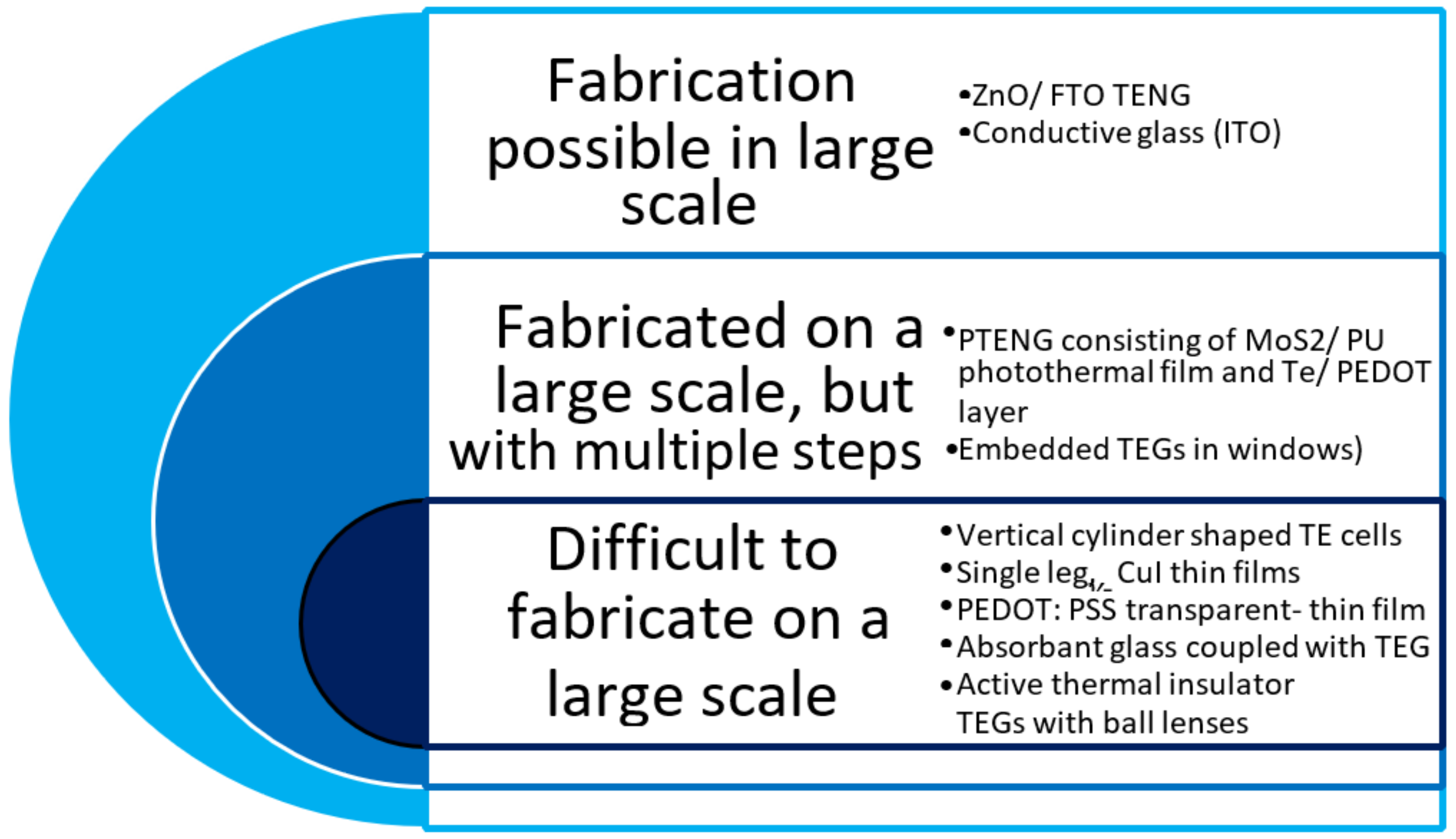
2. Materials and Methods
3. Results and Discussion
3.1. Integrated and Non-Integrated TE Systems
3.1.1. Integrated TE Systems
3.1.2. Non-Integrated TE Systems
3.2. Engineering Insights into Real Life Use Case of Thermoelectric Heating and Cooling Unit (TCHU) as Studied in [19]:
- Cooling Insights:
- Power Consumption Difference: in the cooling experiments, two different voltages were applied: 7.2 V and 12 V. Interestingly, even though the voltage was higher in the 12 V case, the heat absorbed (Qc) showed only a small difference of about 100 W compared to the 7.2 V case. This can be explained by the temperature difference between the faces of the Peltier cell. In the 7.2 V case, the temperature difference was about 9 °C, while in the 12 V case, it increased to about 17 °C. As explained by Equation (2), temperature difference plays a significant role in power absorption, and a smaller temperature difference results in higher power absorption for the same voltage.
- Joule Effect Impact: however, it’s essential to consider the negative Joule effect included in Equation (2). The Joule effect becomes more pronounced as current intensity increases. This leads to an intriguing finding. It may be more efficient to install more cells with a lower voltage and, consequently, lower current intensity than to use fewer cells at higher intensity. With this approach, the cooling and heating capacities (Qc and Qh) can remain the same, but the coefficient of performance (COP) would improve due to lower electrical power consumption.
- COP Values: the COP obtained in these cooling tests ranged between 0.75 and 0.78 at 7.2 V and between 0.66 and 0.62 at 12 V. It’s worth noting that these values were lower than those reported in some other articles due to the inclusion of fan consumption.
- Qc Variation: the relationship between Qc and different voltage and temperature differences follows a pattern similar to an inverse hyperbolic cosine function. This suggests that increasing the voltage beyond a certain point does not significantly increase Qc. Therefore, it’s crucial to optimize the system based on these findings.
- Heating Insights:
- Higher Heat Generation: in heating mode, the experiments showed that the power generated (Qh) had higher values compared to cooling, as predicted by Equations (1) and (2). In heating mode, the Joule effect was beneficial, meaning that higher current intensity led to higher heat generation (Qh).
- Temperature Difference Impact: similar to cooling, the temperature difference between faces (Th − Tc) also influenced the results. Lower temperature differences resulted in better performance for both absorbed and generated heat. Reducing this temperature difference requires careful design of the façade in which the thermoelectric unit is embedded.
- COP Values in Heating: the COP values obtained at 7.2 V ranged between 0.80 and 0.86, while at 12 V, they ranged between 1.40 and 1.30. These values included the impact of fan consumption, and further tests without fans were suggested to assess their effect on system performance.
- Qh Variation: the relationship between Qh and different voltage and temperature differences follows a profile similar to an exponential function. This indicates that power generation rapidly increases with voltage in heating mode.
3.3. General Insights of TCHU
- Optimal Design: the findings emphasize the importance of carefully designing the thermoelectric cooling and heating unit (TCHU) and its embedded façade to minimize the temperature difference between faces, thereby enhancing performance.
- Control System Optimization: a more precise control system could further improve system efficiency. By regulating the system based on temperature differences, it’s possible to work within a more efficient range.
- Cell Configuration: installing more cells and operating them at lower intensity and voltage levels appears to be more efficient than using fewer cells at higher intensity and voltage. However, a cost–benefit analysis is recommended to determine if the additional investment is justified.
- System Emphasis: depending on the climate and application, it may be more advantageous to design the TCHU as a cooling machine, as indicated by higher COP values in cooling mode.
3.4. Engineering Insights into the Real Life Use Case of Ventilated Active Thermoelectric Envelope (VATE) as Studied in [51]
- Seasonal Temperature Variation: the system effectively maintains a constant interior temperature of 21 °C during winter (Test 1.1). However, during summer (Test 1.2), even with a set point of 23 °C, the interior temperature can rise to 32 °C due to the influence of solar radiation.
- Solar Radiation Impact: solar radiation has a pronounced impact on system performance, particularly during summer. This leads to temperature peaks during the late afternoon, with differences of up to 25 °C between the cavity and exterior temperatures (Test 3.2).
- Ventilation Benefit in Winter: during winter, the ventilated façade facilitates heat loss, as evidenced by similar cavity and exterior temperatures during the night (Test 2.1)
- Thermal Bridge Effect: integrating the thermoelectric system creates a thermal bridge, causing a drop in thermal resistance. This effect is particularly significant during maximum solar radiation, resulting in temperature peaks inside the prototype, especially during summer (Tests 2.2 and 3.2).
- Heat Transfer Mechanisms: convection and conduction play a role in heat transfer. Conduction becomes more relevant with the thermoelectric system, leading to higher inside temperatures when solar radiation is intense (Test 2.2). In non-ventilated façades, the conduction effect is less pronounced (Test 3.2).
3.5. Difference between TCHU and VATE Based on Their Respective Engineering Insights
4. Perspective
5. Conclusions
Author Contributions
Funding
Conflicts of Interest
References
- Klochko, N.; Klepikova, K.; Kopach, V.; Tyukhov, I.; Starikov, V.; Sofronov, D.; Khrypunova, I.; Zhadan, D.; Petrushenko, S.; Dukarov, S.; et al. Development of semi-transparent ZnO/FTO solar thermoelectric nanogenerator for energy efficient glazing. Solar Energy 2019, 184, 230–239. [Google Scholar] [CrossRef]
- Liu, Z.; Zhang, L.; Gong, G.; Li, H.; Tang, G. Review of solar thermoelectric cooling technologies for use in zero energy buildings. Energy Build. 2015, 102, 207–216. [Google Scholar] [CrossRef]
- Trancossi, M.; Cannistraro, G.; Pascoa, J. Thermoelectric and solar heat pump use toward self sufficient buildings: The case of a container house. Therm. Sci. Eng. Prog. 2020, 18, 100509. [Google Scholar] [CrossRef]
- Martinez, A.; Astrain, D.; Rodriguez, A.; Aranguren, P. Advanced computational model for Peltier effect based refrigerators. Appl. Therm. Eng. 2016, 95, 339–347. [Google Scholar] [CrossRef]
- He, W.; Zhang, G.; Zhang, X.; Ji, J.; Li, G.; Zhao, X. Recent development and application of thermoelectric generator and cooler. Appl. Energy 2015, 143, 1–25. [Google Scholar] [CrossRef]
- Aksamija, A.; Aksamija, Z.; Counihan, C.; Brown, D.; Upadhyaya, M. Experimental Study of Operating Conditions and Integration of Thermoelectric Materials in Facade Systems. Front. Energy Res. 2019, 7, 6. [Google Scholar] [CrossRef]
- Han, T.; Gong, G.; Liu, Z.; Zhang, L. Optimum design and experimental study of a thermoelectric ventilator. Appl. Therm. Eng. 2014, 67, 529–539. [Google Scholar] [CrossRef]
- Wang, X.; Liang, R.; Fisher, P.; Chan, W.; Xu, J. Critical design features of thermal-based radioisotope generators: A review of the power solution for polar regions and space. Renew. Sustain. Energy Rev. 2019, 119, 109572. [Google Scholar] [CrossRef]
- Zhuang, N.; Yang, C.; Zhao, Y.; Song, Y.; Tang, X. Progress and Prospects of Some Key Technologies for Space Nuclear Reactor. In International Conference on Nuclear Engineering; American Society of Mechanical Engineers Digital Collection: New York, NY, USA, 2021. [Google Scholar] [CrossRef]
- Ko, S.H.; Grigoropoulos, C.P. Hierarchical Nanostructures for Energy Devices; Royal Society of Chemistry: London, UK, 2015. [Google Scholar]
- Najjar, M.K.; Figueiredo, K.; Hammad, A.W.A.; Tam, V.W.Y.; Evangelista, A.C.J.; Haddad, A. A framework to estimate heat energy loss in building operation. J. Clean. Prod. 2019, 235, 789–800. [Google Scholar] [CrossRef]
- Ghosh, A. Potential of building integrated and attached/applied photovoltaic (BIPV/BAPV) for adaptive less energy-hungry building’s skin: A comprehensive review. J. Clean. Prod. 2020, 276, 123343. [Google Scholar] [CrossRef]
- Biyik, E.; Araz, M.; Hepbasli, A.; Shahrestani, M.; Yao, R.; Shao, L.; Essah, E.; Oliveira, A.C.; del Caño, T.; Rico, E.; et al. A key review of building integrated photovoltaic (BIPV) systems. Eng. Sci. Technol. Int. J. 2017, 20, 833–858. [Google Scholar] [CrossRef]
- Bloem, J.J. Evaluation of a PV-integrated building application in a well-controlled outdoor test environment. Build. Environ. 2008, 43, 205–216. [Google Scholar] [CrossRef]
- Irshad, K.; Habib, K.; Saidur, R.; Kareem, M.W.; Saha, B.B. Study of thermoelectric and photovoltaic facade system for energy efficient building development: A review. J. Clean. Prod. 2018, 209, 1376–1395. [Google Scholar] [CrossRef]
- Babu, C.; Ponnambalam, P. The role of thermoelectric generators in the hybrid PV/T systems: A review. Energy Convers. Manag. 2017, 151, 368–385. [Google Scholar] [CrossRef]
- Zuazua-Ros, A.; Martín-Gómez, C.; Ibañez-Puy, E.; Vidaurre-Arbizu, M.; Gelbstein, Y. Investigation of the thermoelectric potential for heating, cooling and ventilation in buildings: Characterization options and applications. Renew. Energy 2019, 131, 229–239. [Google Scholar] [CrossRef]
- Wang, P.; Liu, Z.; Chen, D.; Li, W.; Zhang, L. Experimental study and multi-objective optimisation of a novel integral thermoelectric wall. Energy Build. 2021, 252, 111403. [Google Scholar] [CrossRef]
- Ibañez-Puy, M.; Bermejo-Busto, J.; Martín-Gómez, C.; Vidaurre-Arbizu, M.; Sacristán-Fernández, J.A. Thermoelectric cooling heating unit performance under real conditions. Appl. Energy 2017, 200, 303–314. [Google Scholar] [CrossRef]
- Wu, Y.-Y.; Wu, S.-Y.; Xiao, L. Performance analysis of photovoltaic–thermoelectric hybrid system with and without glass cover. Energy Convers. Manag. 2015, 93, 151–159. [Google Scholar] [CrossRef]
- Luo, Y.; Zhang, L.; Liu, Z.; Wang, Y.; Meng, F.; Wu, J. Thermal performance evaluation of an active building integrated photovoltaic thermoelectric wall system. Appl. Energy 2016, 177, 25–39. [Google Scholar] [CrossRef]
- Ascencio-Vásquez, J.; Brecl, K.; Topič, M. Methodology of Köppen-Geiger-Photovoltaic climate classification and implications to worldwide mapping of PV system performance. Sol. Energy 2019, 191, 672–685. [Google Scholar] [CrossRef]
- Luo, Y.; Zhang, L.; Liu, Z.; Wu, J.; Zhang, Y.; Wu, Z.; He, X. Performance analysis of a self-adaptive building integrated photovoltaic thermoelectric wall system in hot summer and cold winter zone of China. Energy 2017, 140, 584–600. [Google Scholar] [CrossRef]
- Irshad, K.; Habib, K.; Kareem, M.W.; Basrawi, F.; Saha, B.B. Evaluation of thermal comfort in a test room equipped with a photovoltaic assisted thermo-electric air duct cooling system. Int. J. Hydrogen Energy 2017, 42, 26956–26972. [Google Scholar] [CrossRef]
- Duan, M.; Sun, H.; Lin, B.; Wu, Y. Evaluation on the applicability of thermoelectric air cooling systems for buildings with thermoelectric material optimization. Energy 2021, 221, 119723. [Google Scholar] [CrossRef]
- Al-Fartoos, M.M.R.; Roy, A.; Mallick, T.K.; Tahir, A.A. A Short Review on Thermoelectric Glazing for Sustainable Built Environment. Energies 2022, 15, 9589. [Google Scholar] [CrossRef]
- Tainoff, D.; Proudhom, A.; Tur, C.; Crozes, T.; Dufresnes, S.; Dumont, S.; Bourgault, D.; Bourgeois, O. Network of thermoelectric nanogenerators for low power energy harvesting. Nano Energy 2019, 57, 804–810. [Google Scholar] [CrossRef]
- Yang, Y.; Guo, W.; Pradel, K.C.; Zhu, G.; Zhou, Y.; Zhang, Y.; Hu, Y.; Lin, L.; Wang, Z.L. Pyroelectric Nanogenerators for Harvesting Thermoelectric Energy. Nano Lett. 2012, 12, 2833–2838. [Google Scholar] [CrossRef]
- Zhang, Y.; Heo, Y.-J.; Park, M.; Park, S.-J. Recent Advances in Organic Thermoelectric Materials: Principle Mechanisms and Emerging Carbon-Based Green Energy Materials. Polymers 2019, 11, 167. [Google Scholar] [CrossRef] [PubMed]
- Zulkepli, N.; Yunas, J.; Mohamed, M.A.; Hamzah, A.A. Review of Thermoelectric Generators at Low Operating Temperatures: Working Principles and Materials. Micromachines 2021, 12, 734. [Google Scholar] [CrossRef] [PubMed]
- Nandihalli, N. Thermoelectric films and periodic structures and spin Seebeck effect systems: Facets of performance optimization. Mater. Today Energy 2022, 25, 100965. [Google Scholar] [CrossRef]
- O’Sullivan, K.; Henwood, K.; Pidgeon, N. Active Buildings in the Changing Policy Landscape: Conceptual Challenges and Social Scientific Perspectives; Cardiff University: Cardiff, UK, 2020; Available online: https://orca.cardiff.ac.uk/id/eprint/156188/ (accessed on 3 April 2023).
- Directive 2010/31/EU of the European Parliament and of the Council of 19 May 2010 on the Energy Performance of Buildings’. Available online: https://eur-lex.europa.eu/legal-content/EN/TXT/?uri=celex%3A32010L0031 (accessed on 5 June 2023).
- Luo, Y.; Zhang, L.; Liu, Z.; Yu, J.; Xu, X.; Su, X. Towards net zero energy building: The application potential and adaptability of photovoltaic-thermoelectric-battery wall system. Appl. Energy 2019, 258, 114066. [Google Scholar] [CrossRef]
- Gu, W.; Ma, T.; Song, A.; Li, M.; Shen, L. Mathematical modelling and performance evaluation of a hybrid photovoltaic-thermoelectric system. Energy Convers. Manag. 2019, 198, 111800. [Google Scholar] [CrossRef]
- Luo, Y.; Cheng, N.; Zhang, S.; Tian, Z.; Xu, G.; Yang, X.; Fan, J. Comprehensive energy, economic, environmental assessment of a building integrated photovoltaic-thermoelectric system with battery storage for net zero energy building. Build. Simul. 2022, 15, 1923–1941. [Google Scholar] [CrossRef]
- Vassiliades, C.; Agathokleous, R.; Barone, G.; Forzano, C.; Giuzio, G.; Palombo, A.; Buonomano, A.; Kalogirou, S. Building integration of active solar energy systems: A review of geometrical and architectural characteristics. Renew. Sustain. Energy Rev. 2022, 164, 112482. [Google Scholar] [CrossRef]
- Jia, J.; Gao, F.; Cheng, Y.; Wang, P.; EI-Ghetany, H.H.; Han, J. A comparative study on thermoelectric performances and energy savings of double-skin photovoltaic windows in cold regions of China. Solar Energy 2020, 206, 464–472. [Google Scholar] [CrossRef]
- Khalvati, F.; Omidvar, A.; Hadianfard, F. Study on summer thermal performance of a solar ventilated window integrated with thermoelectric air-cooling system. Int. J. Energy Environ. Eng. 2021, 12, 419–432. [Google Scholar] [CrossRef]
- Zhang, J.; Messac, A.; Zhang, J.; Chowdhury, S. Adaptive optimal design of active thermoelectric windows using surrogate modeling. Optim. Eng. 2013, 15, 469–483. [Google Scholar] [CrossRef]
- Kim, C.; Kim, K. Enhancement of solar thermoelectric power generation by optical and thermal management with highly transparent aerogel window. Sol. Energy Mater. Sol. Cells 2021, 230, 111224. [Google Scholar] [CrossRef]
- Kang, S.; Hwang, T.; Kim, J.T. Theoretical analysis of the blinds integrated photovoltaic modules. Energy Build. 2012, 46, 86–91. [Google Scholar] [CrossRef]
- Li, T.; Tang, G.; Gong, G.; Zhang, G.; Li, N.; Zhang, L. Investigation of prototype thermoelectric domestic-ventilator. Appl. Therm. Eng. 2009, 29, 2016–2021. [Google Scholar] [CrossRef]
- Liu, D.; Zhao, F.-Y.; Yang, H.; Tang, G.-F. Theoretical and experimental investigations of thermoelectric heating system with multiple ventilation channels. Appl. Energy 2015, 159, 458–468. [Google Scholar] [CrossRef]
- Siddique, A.R.M.; Mahmud, S.; Heyst, B.V. A comprehensive review on a passive (phase change materials) and an active (thermoelectric cooler) battery thermal management system and their limitations. J. Power Sources 2018, 401, 224–237. [Google Scholar] [CrossRef]
- Astrain, D.; Vián, J.G.; Domı, M. Increase of COP in the thermoelectric refrigeration by the optimization of heat dissipation. Appl. Therm. Eng. 2003, 23, 2183–2200. [Google Scholar] [CrossRef]
- Elsheikh, M.H.; Shnawah, D.A.; Sabri, M.F.M.; Said, S.B.M.; Hassan, M.H.; Bashir, M.B.A.; Mohamad, M. A review on thermoelectric renewable energy: Principle parameters that affect their performance. Renew. Sustain. Energy Rev. 2014, 30, 337–355. [Google Scholar] [CrossRef]
- Cosnier, M.; Fraisse, G.; Luo, L. An experimental and numerical study of a thermoelectric air-cooling and air-heating system. Int. J. Refrig. 2008, 31, 1051–1062. [Google Scholar] [CrossRef]
- Martín-Gómez, C.; Ibáñez-Puy, M.; Bermejo-Busto, J.; Fernández, J.A.S.; Ramos, J.C.; Rivas, A. Thermoelectric cooling heating unit prototype. Build. Serv. Eng. Res. Technol. 2015, 37, 431–449. [Google Scholar] [CrossRef]
- Tan, G.; Zhao, D. Study of a thermoelectric space cooling system integrated with phase change material. Appl. Therm. Eng. 2015, 86, 187–198. [Google Scholar] [CrossRef]
- Ibañez-Puy, M.; Martín-Gómez, C.; Bermejo-Busto, J.; Sacristán, J.A.; Ibañez-Puy, E. Ventilated Active Thermoelectric Envelope (VATE): Analysis of its energy performance when integrated in a building. Energy Build. 2018, 158, 1586–1592. [Google Scholar] [CrossRef]
- Bell, L.E. Addressing the Challenges of Commercializing New Thermoelectric Materials. J. Electron. Mater. 2009, 38, 1344–1349. [Google Scholar] [CrossRef]
- Williams, J.B.; Morelli, D.T. Using Ge Secondary Phases to Enhance the Power Factor and Figure of Merit of Ge17Sb2Te20. J. Electron. Mater. 2016, 46, 2652–2661. [Google Scholar] [CrossRef]
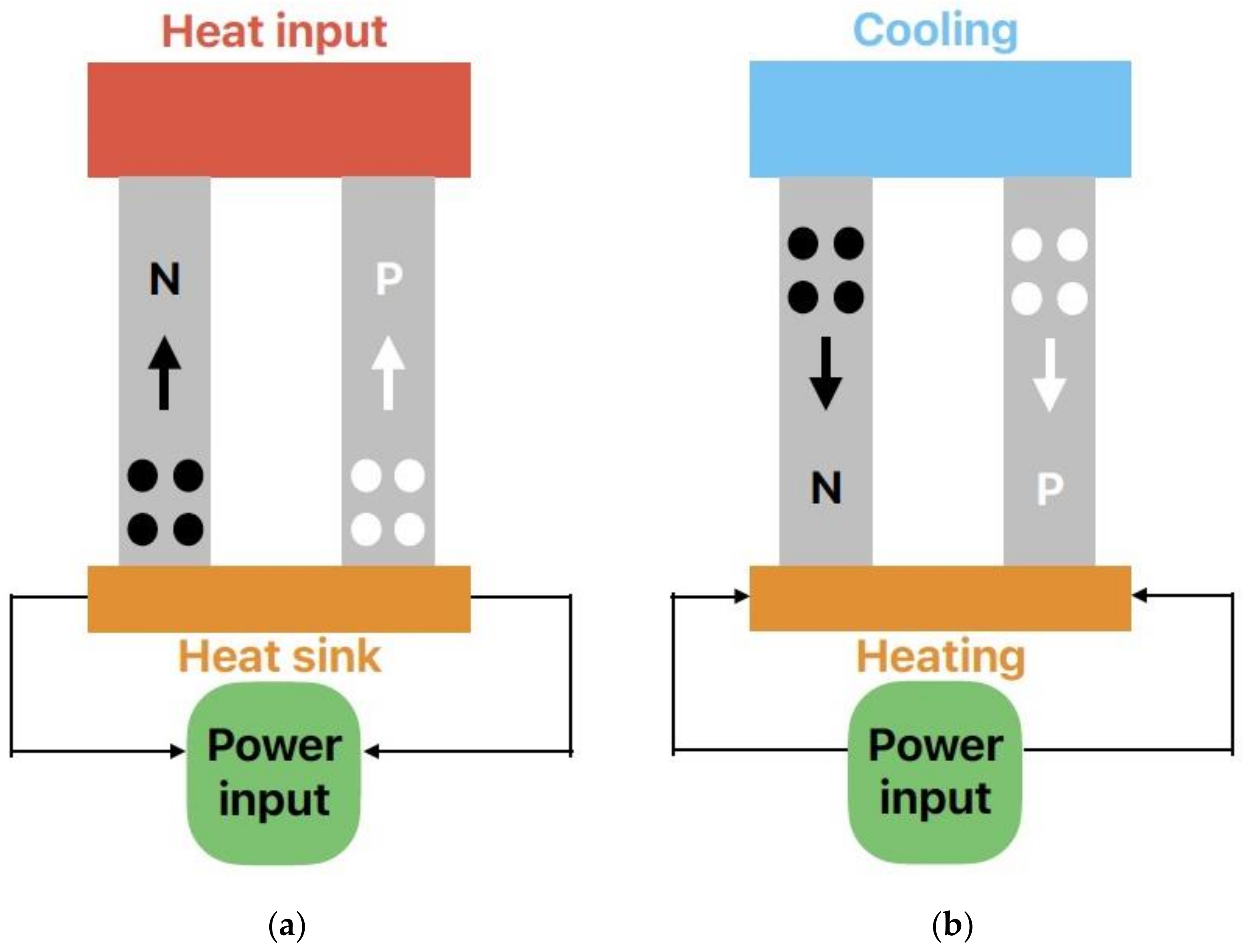

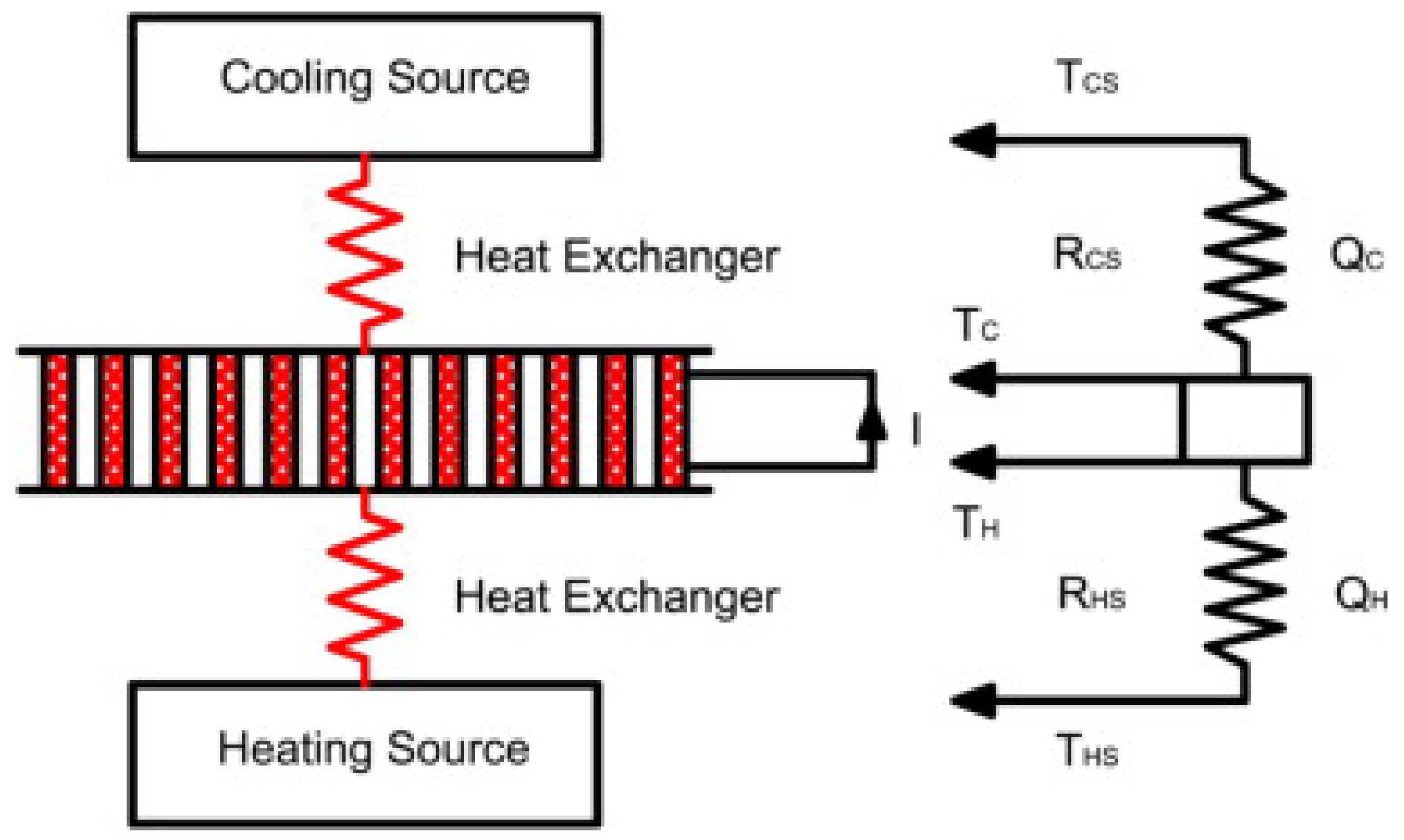

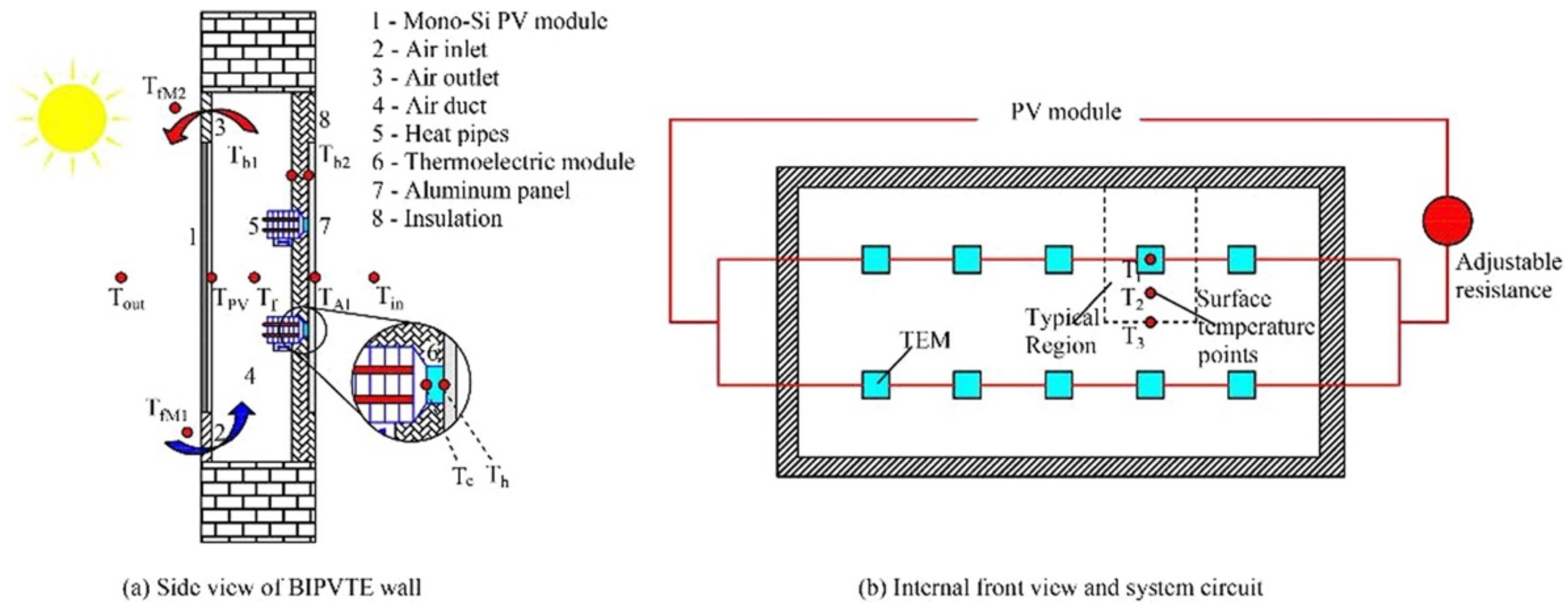
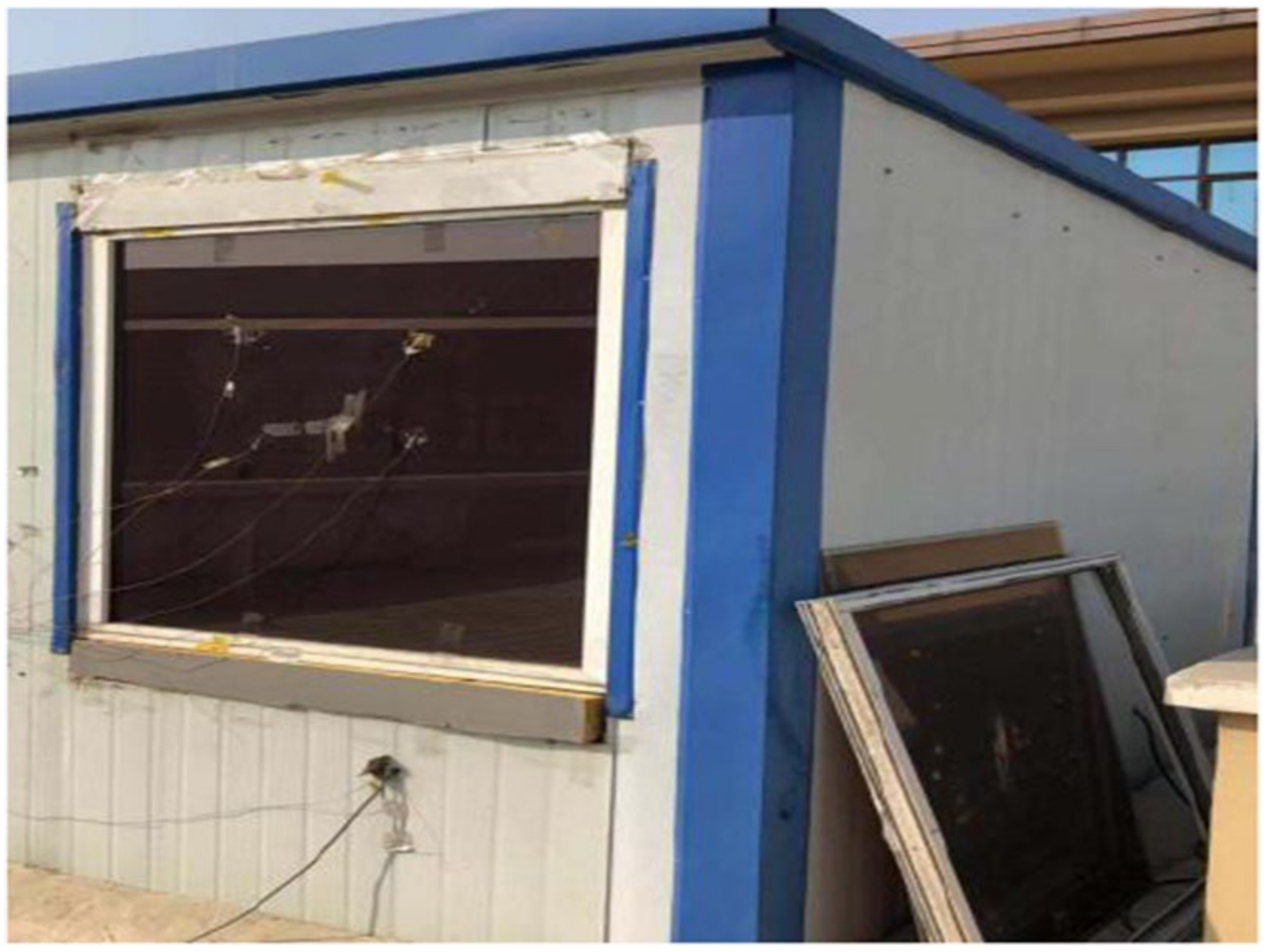
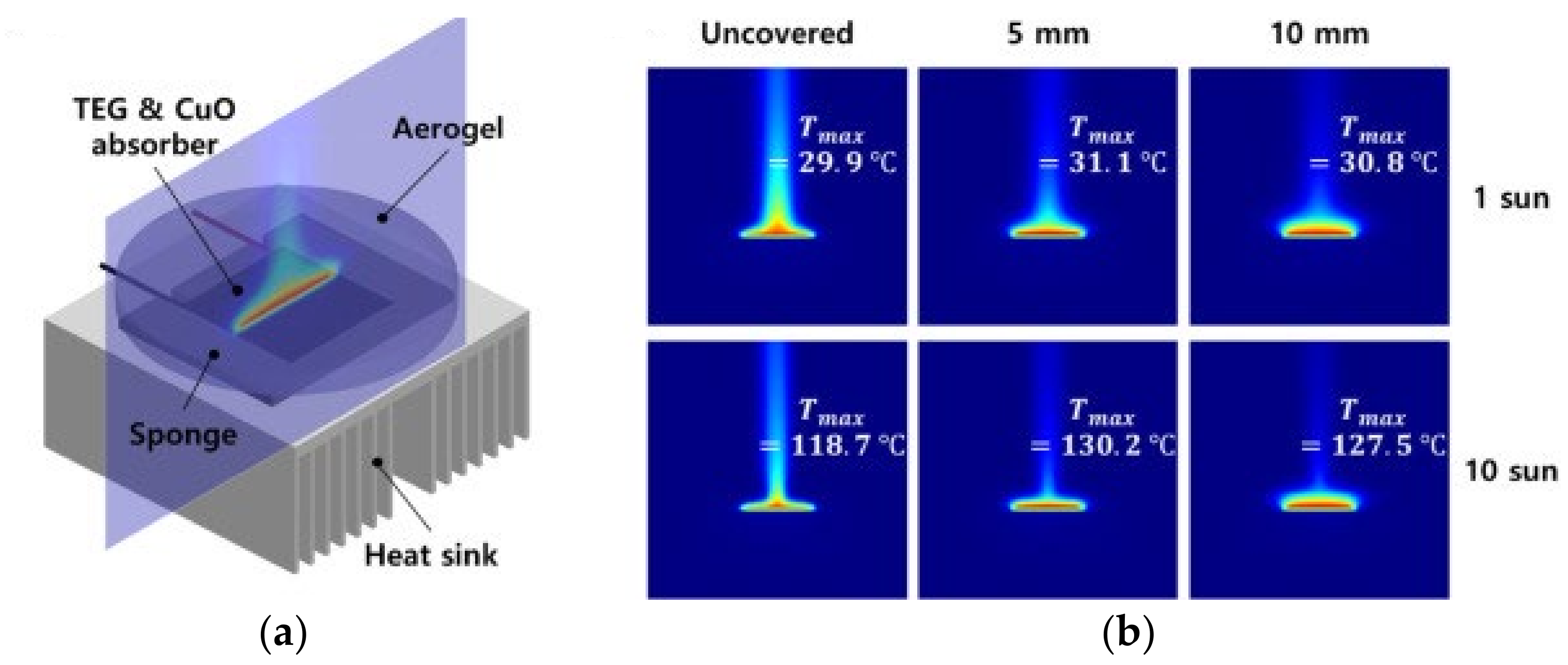

| Aspect | Cooling Insights | Heating Insights |
|---|---|---|
| Power Consumption Difference: | Voltage: 7.2 V | Voltage: 7.2 V |
| Qc Difference: ~100 W | Qh Range: 0.80–0.86 | |
| Joule Effect Impact | Negative in Cooling | Lower temperature difference improves |
| COP Values | Range: 0.75–0.78 at 7.2 V | Range: 1.40–1.30 |
| Range: 0.66–0.62 at 12 V | ||
| Qc and Qh Variation | Similar to inverse hyperbolic cosine function | Follows an exponential profile |
| Control System Optimization | Consider more precise control system for optimal performance | Suggests a more precise control system for optimal performance |
| Cell Configuration | Installing more cells at lower intensity and voltage levels for more efficiency | Emphasizes installing more cells at lower intensity and voltage levels |
| System Emphasis | Emphasizes designing as a cooling machine and a higher COP in cooling mode | Depending on the climate, designing as a heating machine may prove to be disadvantageous |
| Aspect | TCHU System | VATE System |
|---|---|---|
| Temperature Control | Effective control for both heating and cooling with COP between 0.62–1.40 (12 V) and 0.75–0.78 (7.2 V) | Significant temperature variations observed, with peaks of up to 32 °C during summer due to solar radiation |
| Influence of Solar Radiation | Limited influence observed, mainly due to variations in temperature differences | Solar radiation has a pronounced impact, leading to temperature peaks during summer |
| Ventilation Benefits | Ventilation can improve heat loss in winter | Ventilation effect on temperature is less pronounced |
| Thermal Bridge Effect | Integrating the TCHU creates a thermal bridge, leading to significant temperature peaks | Thermal bridge effect noted due to integration of thermoelectric system in the façade |
| Heat Transfer Mechanisms | Conduction and convection play a role, with conduction becoming more relevant | Conduction effect more pronounced in the presence of the thermoelectric system |
| System Efficiency | OP values of 0.62–1.40 achieved with a voltage range of 7.2–12 V | Difficulty in achieving comfort temperature due to solar radiation effects |
| Overall Performance | Effective system operation but with consideration for fans’ energy consumption | Performance not as expected, especially during summer |
Disclaimer/Publisher’s Note: The statements, opinions and data contained in all publications are solely those of the individual author(s) and contributor(s) and not of MDPI and/or the editor(s). MDPI and/or the editor(s) disclaim responsibility for any injury to people or property resulting from any ideas, methods, instructions or products referred to in the content. |
© 2023 by the authors. Licensee MDPI, Basel, Switzerland. This article is an open access article distributed under the terms and conditions of the Creative Commons Attribution (CC BY) license (https://creativecommons.org/licenses/by/4.0/).
Share and Cite
Iyer, R.; Ghosh, A. Investigation of Integrated and Non-Integrated Thermoelectric Systems for Buildings—A Review. Energies 2023, 16, 6979. https://doi.org/10.3390/en16196979
Iyer R, Ghosh A. Investigation of Integrated and Non-Integrated Thermoelectric Systems for Buildings—A Review. Energies. 2023; 16(19):6979. https://doi.org/10.3390/en16196979
Chicago/Turabian StyleIyer, Ramakrishnan, and Aritra Ghosh. 2023. "Investigation of Integrated and Non-Integrated Thermoelectric Systems for Buildings—A Review" Energies 16, no. 19: 6979. https://doi.org/10.3390/en16196979
APA StyleIyer, R., & Ghosh, A. (2023). Investigation of Integrated and Non-Integrated Thermoelectric Systems for Buildings—A Review. Energies, 16(19), 6979. https://doi.org/10.3390/en16196979







